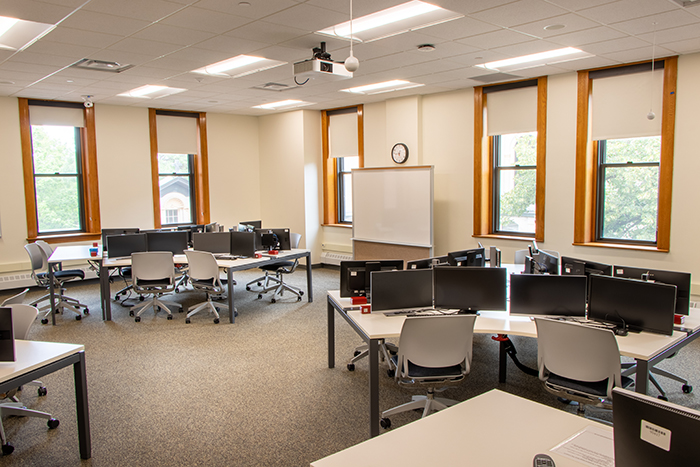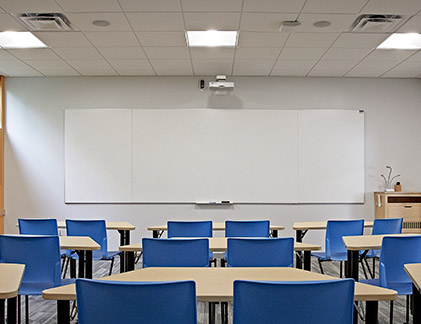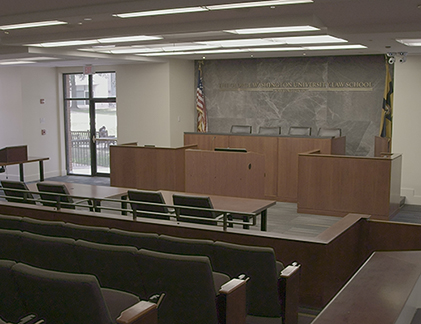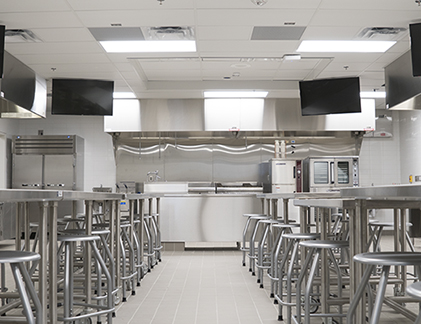The Situation:
The College of Saint Benedict and Saint John’s University (CSBSJU) are two private colleges located in St. Joseph and Collegeville, Minnesota, USA. The leadership team overseeing the two colleges needed to rapidly develop a technology plan to offer synchronized in-person and virtual learning to returning students in the fall of 2020 during the COVID-19 pandemic. Because the campuses are solely comprised of students residing on campus, and the in-person experience is vital to their curriculum, video and audio recording systems were not part of the existing classroom A/V solutions. How could the colleges best recreate the in-person experience for half of the students who were in the distance-learning group of the hybrid model and limit additional burden on their faculty?
The Solution:
The Chief Information Officer, Casey Gordon, and Adam Bauer, the Classroom Support and A/V Manager at CSBSJU knew during the previous spring semester that they’d need to come up with a permanent solution that would better engage their students who take part in the hybrid learning model. They surveyed both students and faculty to understand what went well in the previous semester and what were opportunities for improvement.
“We knew from the survey that the students and our faculty missed the in-person component,” said Gordon. “Our goal was to figure out how to use this technology to allow for some in-person and combine that with some remote, because we also know some students and faculty are part of a vulnerable population and would need to be remote this fall.”

They previously used Vaddio videoconferencing cameras and microphones in a few conference rooms and were happy with the quality and ease-of-use of those systems. During the initial meeting with their AV integrator, EPA Audio Visual, they laid out their system requirements and then brainstormed options. “We told EPA that the system needed to be cost effective, it needs to be quick to install, and needs to be consistent for our faculty to know how to use. If they’re teaching in this classroom one day and then they’re teaching in a different classroom another day, they need to know how to use it,” said Bauer. “We can’t keep retraining folks and so keeping the microphones and cameras consistent is essential.”
They also needed the solution to be simple to install so their small on-campus AV team could outfit the 110 classrooms in just under 6 weeks, in time for the fall semester. Being able to power and connect the cameras and microphones with category cabling saved time and money. They were able to avoid time intensive local power drops or requiring expensive USB extension. It also helped to reduce costs and save time when the Vaddio equipment worked seamlessly with existing Crestron equipment without custom programming.
One of the most important factors for Gordon was that the colleges had to deliver the best possible experience on the far end for their students – they must be able to hear the instructor clearly and have video that makes them feel like they are sitting alongside the rest of the class. What they ultimately standardized on was one EasyIP 10 PTZ camera, two CeilingMIC microphones, one EasyIP Decoder to connect the audio and video with Zoom videoconferencing software, and one Luxul AMS-1208P to power and connect the devices. TheEasyIP Decoder is mounted into every lectern and connects to the faculty laptop via a USB 3.0 cable to act as the default audio and video source for the Zoom session. The system is plug and play with no drivers or additional applications to install.
For a small on-campus A/V team, adding over a hundred PTZ cameras and two hundred microphones could be a daunting support task. Bauer is confident his team can handle the support and training on the new system. Vaddio’s EasyIP systems are simple to manage for Bauer’s team using the included Vaddio Deployment Tool application. Having the ability to remotely view streaming quality, see device status, and troubleshoot basic issues like someone mistakenly muting the video or microphone is invaluable as every class will now employ the equipment.
The Results
“We wrapped up the installations this week, almost a month ahead of time, and we couldn’t have done it without EPA. To go through and say from the time we started talking to the time we’re done was three months,” said Bauer. “It’s incredible.”
The pandemic pushed CSBSJU into new instruction models and decisions were made much quicker than previous large technology investments. “I think one of the major reasons that leadership was willing to invest in this technology so quickly is not just that it's relevant for the pandemic, but it will strategically set us up in terms of being able to stream or record any class in the future. It really is a strategic decision.” Said Gordon. “It's not just an emergency response and that's one of the reasons we were able to make that call so quickly.”

The Equipment:
Each classroom included:
- Vaddio EasyIP 10 Camera (Can scale up to 4)
- EasyIP Decoder
- EasyIP Switch (Luxul AMS-1208P)
- CeilingMIC (1 or 2) or TableMIC (1 or 2)
Faculty laptop with Zoom videoconferencing application installed
The Integrator:
The future looks bright for Grace College students thanks to IDEA and Parallax screens.

GW Law in Washington, D.C. enriches the student learning experience by providing digital classroom recordings with RoboSHOT 12 and 30 PTZ cameras and AV Bridge streaming devices

A new culinary arts program at Shakopee High School prepares students for the foodservice industry

